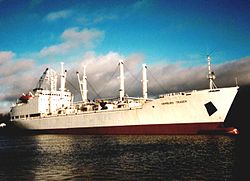Type crystal
|
The Kristall-Schiff Hamburg Trader
|
||||||||||||||||
|
||||||||||||||||
|
||||||||||||||||
|
||||||||||||||||
|
||||||||||||||||
|
||||||||||||||||
|
||||||||||||||||
The three series of the Kristall type were a series of reefer vessels that were built at the Mathias Thesen shipyard in Wismar .
From Polar Type to Crystal Type (1970)
The Kristall-class ships (Kristall I 1978, Kristall II 1983, Kristall III) were developed together with the USSR and have been built since 1970 mainly for the USSR's fishing fleets. They served to supply the fishing flotilla and transported the processed frozen fish to the home ports. They were also set up for passengers, mainly for changing the crew of fishing vessels. Predecessors were the ships of the Polar class (Polar I and Polar II). They were driven by low-speed MAN engines that were built under license in Rostock.
They were reefer ships that were only set up for deep-frozen cargo; they could not transport fruit. The ships were equipped with appropriate loading gear for loading cargo on the high seas and had huge fenders on deck, which were placed between the ships during cargo operations at sea. In addition to fuel and lubricants, drinking water, provisions, packaging material and spare parts were transported to and handed over to the fishing flotilla. The range of the ships is 12,300 nautical miles.
The ships were designed to take over fresh, frozen and processed fish from fishing fleets on the open sea and to transport the cargo to the port of destination. At the same time, they are equipped to supply the fishing and processing vessels with fuel, provisions, equipment and materials, and to look after the crews. Up to 71 people can be accommodated on board.
Technique crystal II
The ships are equipped with waste incineration, waste water treatment and bilge water deoiling systems. The room temperatures of the four holds with a total volume of 13,300 m 3 can be individually regulated in the range of −8 ° C to −30 ° C. Insulated, hydraulically operated folding covers are used to close the cargo holds. In the intermediate decks, forklifts take over the horizontal transport of the load. The on-board handling equipment consists of a 5 t loading boom with a 14 meter radius, six 5 t loading booms with an 18 meter radius and two 10 t loading booms with an 18 meter radius. The load is accepted up to wind force 6 and depending on the size of the ships lying alongside in all four hatches. Up to 250 t per hatch can be taken over in 24 hours. A total of 7460 t of refrigerated cargo, 488 t of fish meal and 174 t of fish oil can be transported.
The main drive is a low- speed cross-head marine diesel engine of the type K 5 SZ 70/125 BL with 7600 kW, built by the Rostock diesel engine plant under a MAN license , with which the single-screw ship reaches 17.4 knots. The radius of action is given as 12,300 nautical miles.
The type Kristall III with basically the same design was still planned, but was no longer built.
Conversion from deep-freeze ship to reefer ship
The Hamburg Trader was originally built with the name Reutershagen as a deep-freeze ship (Freezer) for transporting fish for the VEB Fischkombinat Rostock. It was bought by the Greek shipping company Target (Piraeus), rebuilt to make it pallet-friendly in 1994 and received a. New evaporators, stronger cargo space fans for 90-fold air circulation and a new measurement and control system for the cargo cooling system. This conversion was necessary because, in addition to frozen cargo, fruit cargo (temperature range (−30 to +12 ° C)) should also be transported in the future. It was broken up in April 2010 in Alang (India).
Individual evidence
- ^ Clarkson Research Studies: The Reefer Register. P. 146.
literature
- Alfred Dudszus, Alfred Köpcke: The big book of ship types. Steam ships, motor ships, marine technology from the beginnings of machine-driven ships to the present day. transpress Pietsch, Berlin / Stuttgart 1990, ISBN 3-344-00374-7 , p. 184.
- K. Bartmann, HJ Taeger: Refrigerated ship type crystal. In: Seewirtschaft. No. 10/1979. ISSN 0037-0886

